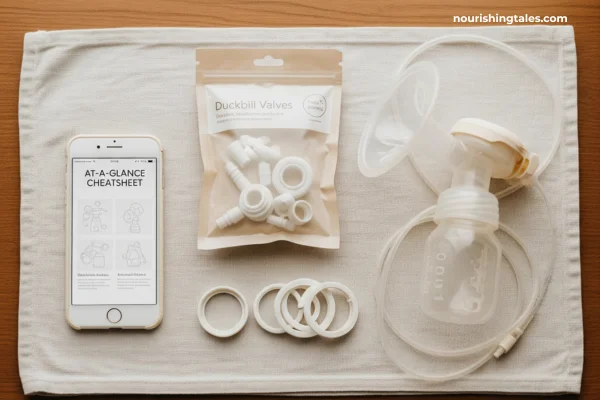Paced bottle feeding can transform your bottle introduction from a source of anxiety into a calm, connected experience. Thinking about introducing a bottle can bring up a whirlwind of emotions. Will it confuse your baby? Will it interfere with breastfeeding? You’re not alone in asking these questions. It’s completely normal to feel a little anxious about navigating this new step.
But what if there was a way to offer a bottle that honours and protects your breastfeeding relationship? A way that puts your baby in control, respects their natural instincts, and makes feeding a calm, connected experience for you both?
There is. It’s called paced bottle-feeding, and it’s a game-changer.
Think of it as mindful, responsive bottle-feeding. Instead of letting gravity do the work and rush the feed, this gentle technique mimics the rhythm and flow of nursing at the breast. It allows your baby to be an active participant, controlling the pace and telling you exactly when they’re full.
Let’s explore how this simple shift can make all the difference.
Three Wonderful Reasons to Try This Method
Beyond just being wonderfully efficient, combining pumping and nursing has some real, tangible benefits for your feeding journey.
- You Reclaim Precious Time: This is the biggest one. Instead of nursing your baby for 20 minutes and then needing another 15-20 minutes to pump later, you do both at once. Those minutes you get back are yours to use however you need—for a warm cup of chai, a quick shower, or just sitting in blissful quiet.
- You Capture More Milk: Have you ever noticed your other breast leaking while your baby nurses? That’s your powerful let-down reflex at work! Your baby is the most effective trigger for this reflex. By attaching a pump or collector to the other side, you harness that natural let-down and collect milk that might otherwise be lost in a breast pad. Many parents find they collect far more this way than during a pump-only session.
- It Can Gently Boost Your Supply: Increased milk removal signals your body to produce more milk. Pumping while you nurse adds another “milk removal” session to your day without adding extra time. If you’re looking for ways to support your production, this is a beautiful, low-stress way to gently increase your milk supply.
The Two Main Approaches (and the Gear You’ll Need)
There are two simple ways to do this, depending on your goals. One is more active for building a stash, and the other is wonderfully passive for effortless collection.
Method 1: Using an Electric or Manual Pump
This is a great option if your goal is to actively build a freezer stash for returning to work or if you want to give your supply a noticeable boost.
- Best for: Parents who want to maximise milk output and build a stash.
- What you’ll need: A single electric or manual pump, a clean collection bottle, and a supportive nursing pillow to keep your hands free. A hands-free pumping bra can be a game-changer for comfort and ease!
Method 2: Using a Silicone Milk Collector
This is the definition of working smarter, not harder. A silicone collector (like the popular Haakaa) uses gentle suction to passively catch the let-down from your non-nursing breast.
- Best for: Parents new to this technique or anyone who wants to build a small stash with almost zero extra effort. It’s perfect for saving every precious drop.
- What you’ll need: A silicone milk collector and a nursing pillow.
Your Simple, Step-by-Step Guide
It might feel a little clumsy at first, but you’ll find your rhythm in no time. The secret is to prepare your space before you pick up your baby.
- Set Up Your Nest First: This is the most important step! Before your baby gets fussy, get everything ready. Assemble your clean pump parts, have your collector within reach, and place a glass of water for yourself nearby. A little preparation prevents a lot of frustration.
- Latch Your Baby Comfortably: Get settled with your nursing pillow and latch your baby on the first breast. Focus on getting a deep, comfortable latch. Your baby’s comfort and feeding always come first.
- Attach Your Pump or Collector: Once your baby is happily nursing, you can attach your device to the other breast.
- For an electric/manual pump: Lean forward just a bit, position the flange, and secure it with your hand or a hands-free bra. A proper fit is key to comfort and output, so ensuring you have the right size is crucial (we have a simple flange sizing guide to help you check). Start the pump on a low setting and adjust as your milk begins to flow.
- For a silicone collector: Squeeze the base, centre it over your nipple, and release. The suction will hold it in place.
- Relax and Let It Flow: Now, the magic happens. As your baby nurses, they will trigger your let-down, and you’ll see milk begin to collect on the other side. You’re simply catching the milk your baby is helping you release.
- Finish the Session: Continue collecting for as long as your baby is actively nursing (usually 10-15 minutes). When they’re done, carefully remove the pump or collector. Once you have your liquid gold, the next step is making sure it’s stored safely for your baby. You can find everything you need to know in our complete guide to storing breast milk.
Tips for a Smooth and Calm Session
- A Nursing Pillow is Your Best Friend: It supports your baby, freeing up your hands and your lap to manage the pump without straining your back.
- Lean Forward to Prevent Spills: When attaching or removing your pump or a full collector, leaning forward slightly can help you avoid losing any of those precious drops.
- Alternate Sides: This is so important! To keep your supply balanced, start your next feed on the breast you pumped from this time. So, if you nursed on the left and pumped on the right, start the next feed on the right.
- Be Patient With Yourself: Like any new skill, this takes a little practice. Don’t worry about how much you collect, especially at first. Every single drop is a victory. You’ll be a pro in just a few sessions.
You’ve Got This
Pumping while breastfeeding is more than a clever hack—it’s a tool that can help you feel more in control of your time and your feeding journey. It’s about finding a rhythm that works for you and your family. Give it a gentle try, be kind to yourself, and celebrate your incredible ability to nourish your baby.
Disclaimer: This article is for informational purposes only and is not a substitute for professional medical advice. Every feeding journey is unique. Please consult with a board-certified lactation consultant (IBCLC) or your healthcare provider for personalized advice.



